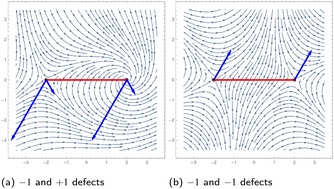Defect dynamics in active polar fluids vs. active nematics
Abstract
Topological defects play a key role in two-dimensional active nematics, and a transient role in two-dimensional active polar fluids. Using a variational method, we study both the transient and long-time behavior of defects in two-dimensional active polar fluids in the limit of strong order and overdamped, compressible flow, and compare the defect dynamics with the corresponding active nematics model studied recently. One result is non-central interactions between defect pairs for active polar fluids, and by extending our analysis to allow orientation dynamics of defects, we find that the orientation of +1 defects, unlike that of ±1/2 defects in active nematics, is not locked to defect positions and relaxes to asters. Moreover, using a scaling argument, we explain the transient feature of active polar defects and show that in the steady state, active polar fluids are either devoid of defects or consist of a single aster. We argue that for contractile (extensile) active nematic systems, +1 vortices (asters) should emerge as bound states of a pair of +1/2 defects, which has been recently observed. Moreover, unlike the polar case, we show that for active nematics, a linear chain of equally spaced bound states of pairs of +1/2 defects can screen the activity term. A common feature in both models is the appearance of +1 defects (elementary in polar and composite in nematic) in the steady state.



 Please wait while we load your content...
Please wait while we load your content...